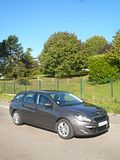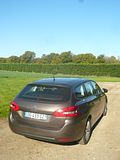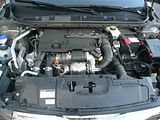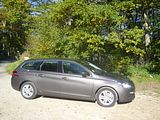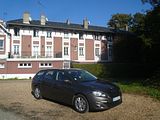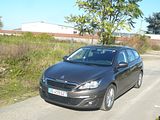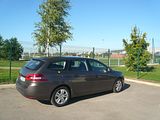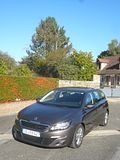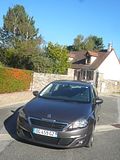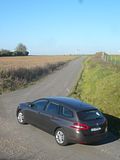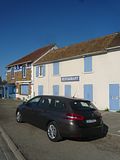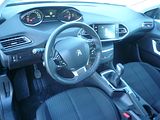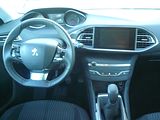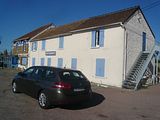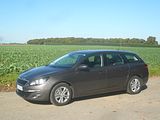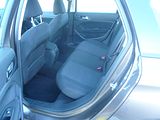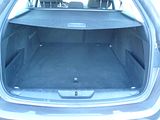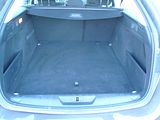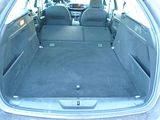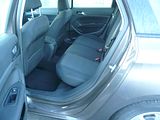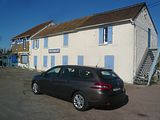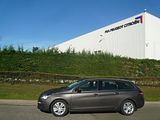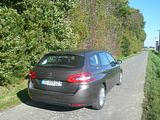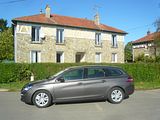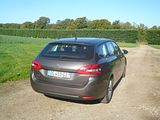
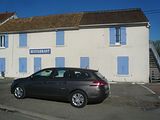
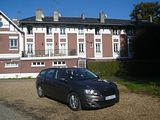
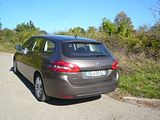


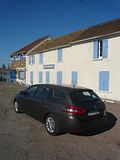

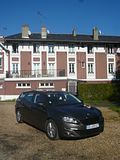


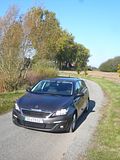


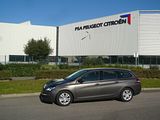

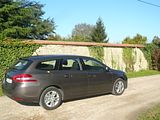




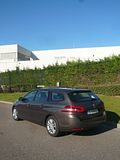
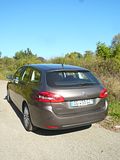

As well as making the 308 look a lot better than its two unloved predecessors, Peugeot needed to make it drive better. In some ways, that was always going to be a tougher challenge, as the economics of modern car production means that you cannot simply throw away what you had and start again, so this 308 was going to have use as much as possible from the corporate parts store. The engines should not be too much of a problem, as, like all manufacturers, there is a constant program of development, necessitated among other reasons by the challenge thrown down by Brussels to reduce the CO2 emissions. Both petrol and diesel 308s are offered, but it was always expected that the diesel would predominate with this car, as indeed it has done for a while in most cars of this size in many European markets. So, whilst Peugeot offer a 1.2 VTi petrol model at the bottom of the range and the more modern THP engine in two further different states of tune, as well as a more potent 1.6 THP in 128 and 156 bhp guises, in practice it is more likely to be the 1.6 HDi engine in the cars that people actually buy. There is also a 2.0 HDi diesel as well, for those with larger budgets. The 1.6s are the big sellers, though, and that applies to the rental fleets acquisition policies as well, so it was no surprise to learn that my test car as a 1.6 HDi. There was nothing to indicate which of the three different versions of the engine was under the bonnet, but a bit of sleuthing (OK, I looked at the “carte grise” in the glovebox) revealed that this car generated 68 KW, which translates to 92 bhp, and combined with a five speed manual box, that meant it was the least powerful of the three 1.6 HDI choices offered.
92 bhp is really not a lot for a car of this size and weight these days, but it did not struggle as much as you might fear. For sure you have to make a lot of use of the gears. They proved well spaced, and once I discovered that there is indeed no 6th (reverse is situated where 6th might be, but there is a strong detent so you cannot select it accidentally), I was able to make decent progress. 5th is quite a high ratio, and cannot really be used if you are travelling at less than 80 km/h. 10 km/h less than this and the engine is spinning at just 1200 rpm, and so it protests about the high gear. The gear shift indicator in the instruments was eager to get you up the first three gears, but then it was less to tell you to go up any more, and that indeed is how I drove it. Although there is a lot of travel between the gears, the quality of the change is not bad, and a vast improvement on the vague sensation I experienced with the 208. The lever clicks and clunks in a positive way as you select a ratio, but it is quite a positive feeling and decently precise, none of which applied to the 208 (or previous Peugeot-Citroen cars of recent memory). I found that once I had adapted to the engine and gear ratio characteristics, the 308 was perfectly able to keep up with the flow of traffic, whether that was on the Champs-Élysées (yes, I did take it there!) or on the autoroute. The engine is nicely refined. Your ears will tell you it is a diesel, but it is not rattly and it is smooth, just endowed with the characteristic, but muted sound that reminds you to refuel from the black pump. I drove 452 km over my two day test, which was not enough to use even half the tank. The needle was not on full when I took the car, so I cannot really tell you what the fuel consumption was, as I certainly returned it showing a full tank. The on-board computer showed an average of 5.2 l/100km when I collected it, and this had improved to 5.0 l/100km when I returned it, but that must mean that in fact I achieved better than that. Surprisingly, there was no Stop/Start system on the car. Engines were not the weakest link in the past 15 years, though, it was the steering and suspension which regressed so much from those Peugeots of the 1990s which scored highly on driving pleasure. I don’t think this 308 goes to the very top of the pack, but it is certainly perfectly acceptable. The steering is not overly light, and whilst it does not hit the standard of feel that Ford deliver in their Focus, it is far from the worst in class. You might think that particularly small steering wheel, more of which later, might then mean that the 308 would be endowed with particularly quick steering, but that’s not the case. What you get from the brand new platform and new suspension set up feels like a sort of unadventurous but perfectly acceptable set up which endows the Peugeot with predictable and safe handling. There’s not much body roll, though it does not corner completely flat. The upside is a comfortable and pliant ride, which seemed to do quite a decent job even at smoothing out the cobbles down the Champs-Élysées. Couple this with low noise levels, and you could certainly conceive taking the 308 on a long cruise down the Autoroutes or ambling along the Routes Nationales without running the risk of complaint from the passengers, as overall refinement is very good. There were no issues with the brakes, which were well judged, having good feel and apposite weighting. On this version, a pull up handbrake is fitted between the seats. Visibility was not bad, with a good field of view from the door mirrors, and there were parking sensors on the back bumper to help you to judge the proximity to any obstacles behind the car.
If Peugeot had been reading the criticism of their products over the past fifteen years, then they will have been only too aware that as well as making their cars better to drive, they also needed to improve the quality of the interiors. A lot. A quick glance inside the 308 suggests that not only have they heeded the words of the detractors, but they have worked hard to endow this car with something that challenges for best in class. The main dash moulding is soft to the touch and has a nice grained texture. Coupled with judicious use of metallised inserts on the door casings, and dash, this all makes the car look massively better than its predecessor. More contentious, though, is Peugeot’s decision to equip the 308 with the same combination of very small diameter and low mounted steering wheel with an instrument pod that you are expected to be able to see above the wheel rather than through it. I came across this in the 208, and found that the perfect driving position for someone of my proportions left the lower half of the instruments badly obscured, so it was quite a relief to discover that in the 308, although the same basic approach has been adopted, I could read the instruments quite clearly. The pod is perched on the top of the dash, quite a lot further back than a more conventional instrument nacelle, but this is not a problem. There are two larger dials, for speedometer and rev counter, which are set a long way apart, and which are flanked by smaller fuel gauge on the left and water temperature on the right. To help matters further, the rev counter arcs in an anti-clockwise direction, so the needle is more likely to be even further from a position of being obscured by the wheel. A central digital display area provides a repeater for the current speed, which I found easier to interpret quickly than looking at the dial, even though this latter was clearly marked. The centre of the dash has been simplified, a lot, by removing almost all the buttons, switches and knobs. A display screen is positioned between the two central air vents, and most of the functions that you need are controlled through this, which has a touch screen interface, supported by a trio of selector switches that are presented vertically on either side of the unit, to take you to one of the sub menus. Beneath this is simply one knob, for audio unit volume and on/off, and then below that are only the switches for the heated rear window and front screen demist. Although operation of the touch screen is relatively simple, things like changing the temperature setting for the climate control are more complicated than with the conventional system of a couple of rotary dials, so whilst the effort to simplify the appearance of the cabin is welcome, and I am sure you would quickly get used to what is where, it did take quite a few minutes study when I first got the car, so I was not convinced that this approach is better than that of some (not Ford!) rivals. Traditional column stalks are used, with that on the left operating the lights as well as indicators, and that on the right, the front and rear wipers. A separate stalk, mounted lower to the left is used for the cruise control. There are some repeater buttons on the steering wheel hub for some audio unit functions. One other thing which did I noticed as different were the sound effects that you get from things such as the indicators. In most cars, the sound is a series of continuous pulses, but the 308 groups the sound in threes. There are some other unusual sounds for opening the door with the key still in the ignition key, or for driving without the seat belt fastened.
Seat adjustment is all manual, in this trim level, with a bar under the seat used to set the chair fore/aft, and a turn wheel rather awkwardly on the side of the seat trapped around the base of the seat belt anchor for continuous backrest angle adjustment. Height is adjusted using a cam lever on the side of the seat. The steering column had an in/out adjustment as well as up/down. Sadly, the seat belt did not seem to be height adjustable, and I would have preferred the belt to be set from higher up than was the case. Nonetheless, the driving position was good, and the seat proved comfortable. It does all still feel a little odd, though, as that small steering wheel is a lot lower, even in highest setting than you will be used to. I cannot say that I prefer it (Peugeot claim that their customers do, but I wonder if this is really true?), but it was not an undue nuisance either.
Modern cars continue to get bigger on the outside without appearing to gain much extra space inside, but the 308 seemed to me that it had actually got notably roomier than some of its antecedents. Rear seat passengers will not want for space, with ample leg room, augmented by the shaping of the back of the front seats and (where no sun roof is fitted) plenty of head room. With a flat floor, there is no problem for a middle seat occupant’s legs and any conflict with a transmission tunnel, and the Peugeot is wide enough that three people should fit. They don’t get the benefit of a central armrest in this version, at least not as standard, though you can specify one as an option. The boot is vast, especially for a car in this class. With the rear seats up, items that I put in the boot and then which slid forward all the way to the front were quit hard to retrieve, especially when they were under the parcel shelf. The boot is long from front to back, and it is also a nice regular shape, with no intrusion on the width from the rear suspension. It is decently deep even under the removable parcel shelf. There are release set in the side trim by the tailgate, as well as on the top of the seat backrests to allow you to drop the backrests – which are asymmetrically split – onto the seat cushions to create a very long, and flat load space. There is a bit of space under the boot floor for odds and ends, and there are two small cubby areas on the side of the boot for odds and ends. Inside the passenger cabin, there is a simply massive glovebox, which goes back a very long way, as well as pockets on all four doors, a small cubby under the central armrest and a little area in front of the gearlever. There are map pockets on the back of the front seats.
Peugeot sell the 308 in four different levels of trim: Access, Active, Allure and Féline. There is no badging on the car to tell you which is which, but my test car would appear to have been an Active. Ignoring the metallic paint, such a car lists at £18,995 in the UK and €24,780 in France. There are a few options available, but as far as I could tell, the only cost feature on the test car was its paint which the French call Métallisée Gris Moka, a sort of brown tinged grey that was not much to my taste. Standard spec includes remote central locking, all round electric windows, dual zone climate control, the touch screen display unit, USB, MP3, AUX and Bluetooth connectivity, a programmable speed limiter/warning, a leather wrapped steering wheel, a third rear seat headrest, split folding rear seats, 16″ alloys, a space saver spare and rear parking sensors. Optional features include the Comfort pack, which gives you a rear central armrest, front fog lights, roof rails, a CD player, and satellite navigation. I was surprised to discover that I had to use the key to release the petrol filler cap under the flap on the rear flanks. Access models are limited to electric windows in the front and manual air conditioning, and have a plastic moulded steering wheel. They come on 15″ steel wheels. Upgrade to the Allure and you get front fog lights, parking sensors at the front as well as rear. a different design of 16″ alloys, an electronic parking brake, rear privacy glass, the Comfort pack and satellite navigation. Current top of the range Féline cars have a Driver Assistance Pack (which includes dynamic cruise control, collision alert and emergency braking system), LED headlights, keyless entry and starting, an electrically operated panoramic glass sunroof, a reversing camera and 17″ alloys.
I was quite impressed by the 308 SW. When it was announced as Car of the Year, I was pretty sure that the judges had (once again) got it wrong, as the other cars on the short list all seemed more worthy of the accolade than this mid-sized Peugeot, but now I’ve driven it, I can at least confirm that it is a sound offering in a fiercely competitive class. Even in a model near the bottom of the range, you get a nicely finished and very roomy Estate car that is pleasingly refined. Provided you can live with the small steering wheel and its position relative to the instruments, this second generation 308 has no real weak point, but nor does it really shine with a compelling advantage over a strong field of rivals. That won’t matter to the French, who will be able to buy the local product, happy that by embracing the domestic offering they are not getting an inferior car as they have been doing for far too long. But to those for whom such nationalist criteria do not apply, this 308 will face a tougher time, as it has plenty of excellent rivals, including the big selling Golf and the driver-satisfying Focus. Whilst I can see that anyone selecting the Peugeot will be perfectly happy with it, if it was me making a choice, I don’t think it would be the top of my list. For me, Seat’s Leon and Skoda’s Octavia do everything that the 308 does with a style which appeals to me that bit more, so they would probably be my choice. But for sure, if the rental car company gives you a Peugeot key, after years of panic or a desperate plea for something else, you should take it, and sample the 2014 Car of the Year for yourself.





